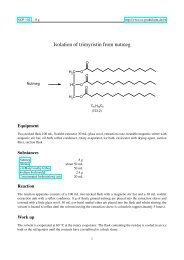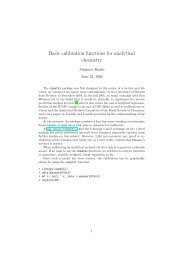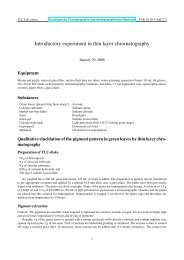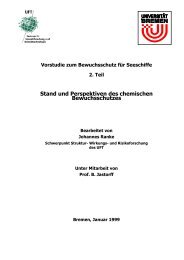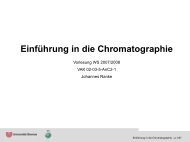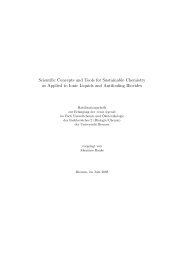Synthesis of acetylsalicylic acid (Aspirin): ⢠Synthesis / working-up ...
Synthesis of acetylsalicylic acid (Aspirin): ⢠Synthesis / working-up ...
Synthesis of acetylsalicylic acid (Aspirin): ⢠Synthesis / working-up ...
You also want an ePaper? Increase the reach of your titles
YUMPU automatically turns print PDFs into web optimized ePapers that Google loves.
<strong>Synthesis</strong> <strong>of</strong> <strong>acetylsalicylic</strong> <strong>acid</strong> (<strong>Aspirin</strong>):OOHO OHO OO H +H+ O +OOOO HSalicylic <strong>acid</strong> Acetic anhydride o-<strong>acetylsalicylic</strong> <strong>acid</strong> Acetic <strong>acid</strong>• <strong>Synthesis</strong> / <strong>working</strong>-<strong>up</strong>• HPLC (reaction control /purity control)
Experimental arrangement:
Mechanism <strong>of</strong> the reaction:• addition-elimination- mechanismelectrophilic carbonlow electron densityO O HOHOδ-O OO O H + HO+ O +δ+OOHlone pairnucleophilehigh electron density
1. step: Activation <strong>of</strong> the electrophile• increase in reactivity
2. Step: Addition reaction3. Step: Elimination reaction
Reaction control:• using the HPLC to follow the course <strong>of</strong> the reaction• take a sample every 20 minutes(before and after the additon <strong>of</strong> sulphuric <strong>acid</strong>)• stop the reaction when no further formation <strong>of</strong> the acetylic salicylic <strong>acid</strong>is observable
Working-<strong>up</strong>: Recrystallisation• Recrystallisation is a fundamental technique usedto purify solid compounds
Recrystallisation is based on the principles <strong>of</strong> solubility:• compounds tend to be more soluble in hot solvents thanthey are in cold liquids• if a saturated hot solution is allowed to cool, the solute isno longer soluble in the solvent and forms crystals <strong>of</strong> purecompound• impurities are excluded from the growing crystals and thepure solid crystals can be separated from the dissolvedimpurities by filtration
Characterisation:• HPLC• melting point determination
Melting point determination:• the determination <strong>of</strong> melting points is one <strong>of</strong> the oldest identification• fast and simple tool• changes from a solid to a liquid state• pure crystalline substances have a clear, sharply defined melting point• a pure substance melts at a precisely defined temperature, characteristic<strong>of</strong> every crystalline substance• to obtain a first impression <strong>of</strong> the purity <strong>of</strong> a substance• small quantities <strong>of</strong> impurities change the melting point
Determination <strong>of</strong> the yield:• you started with 0,05 mol Salicylic <strong>acid</strong> and acetic anhydride• if you have a yield <strong>of</strong> 100% you should obtain 0.05 mol aspirin• 0.05 mol * molecular weight <strong>of</strong> aspirin = X g• balance out your dried product• calculate your aspirin yield in %
Sources <strong>of</strong> risk:Acetic anhydride:
Sources <strong>of</strong> risk:Acetic anhydride:R10 FlammableR20/21 Harmful by inhalation and in contact with skinR34 Causes burns
Salicylic <strong>acid</strong>:
Salicylic <strong>acid</strong>:R22 Harmful if swallowedR41 Risk <strong>of</strong> serious damage to eyes
Sulphuric <strong>acid</strong>:R35 Causes severe burn
Sulphuric <strong>acid</strong>:R35 Causes severe burn



